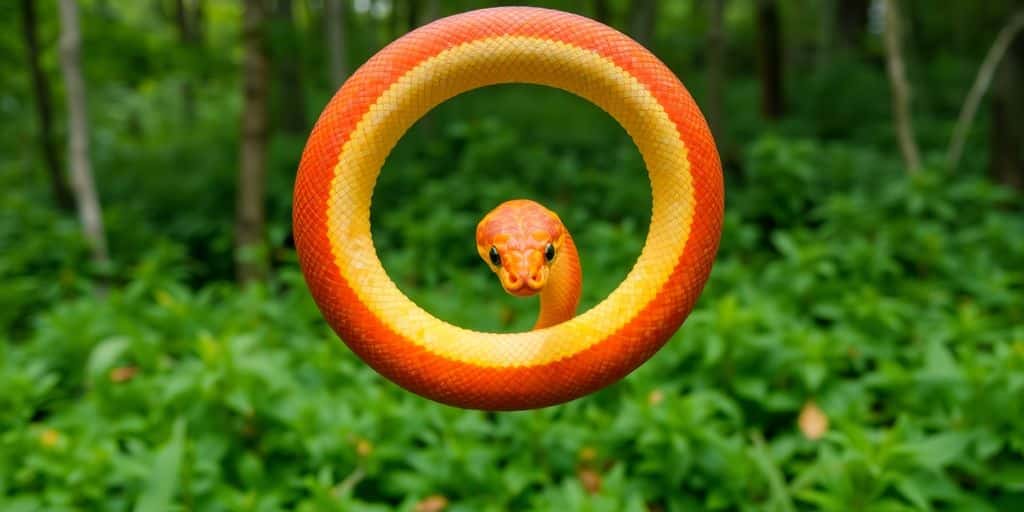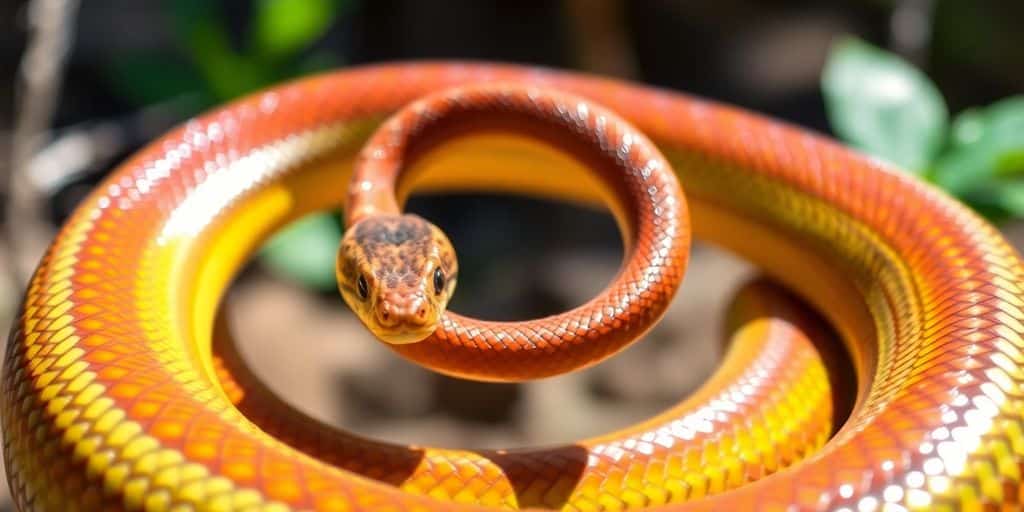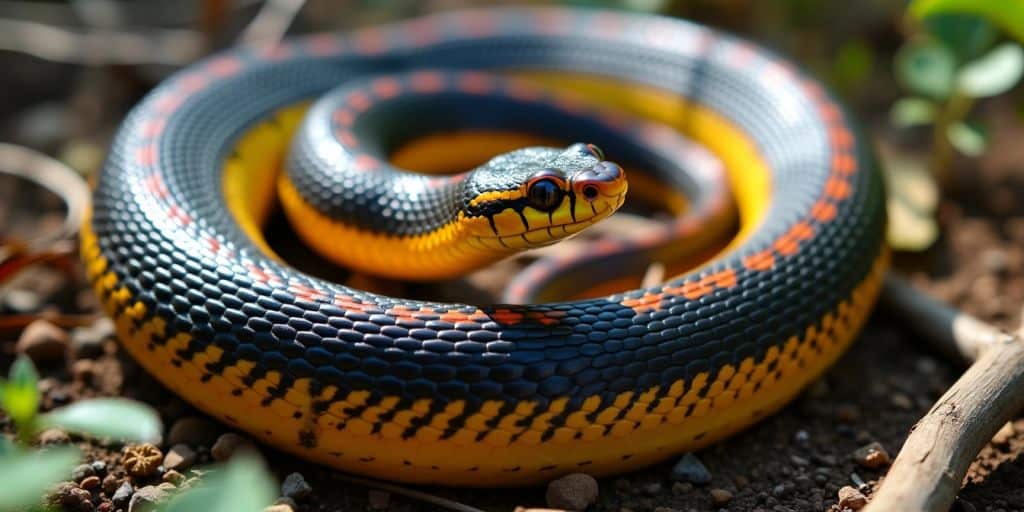The hoop snake is a creature that has captured the imagination of many through myths and stories. While it may not be a real animal, its tales reflect our fascination with snakes and the mysteries surrounding them. In this article, we’ll explore the origins, cultural significance, and biology of the hoop snake, as well as the myths that have arisen around it. Join us on this journey to uncover the truth behind this captivating legend.
Key Takeaways
- The hoop snake is often linked to ancient myths and legends from various cultures.
- Despite its mythical status, the hoop snake has sparked scientific curiosity and theories about snake evolution.
- Cultural representations of the hoop snake vary widely, from Native American stories to modern media.
- Many common beliefs about the hoop snake are misconceptions that lack scientific support.
- Conservation efforts are crucial for protecting real snake species and their habitats.
Origins and Evolution of the Hoop Snake
Ancient Myths and Legends
The hoop snake has been a part of folklore for centuries. Many cultures have their own stories about this creature, often depicting it as a magical being. For instance, in some Native American tales, the hoop snake is said to roll into a circle and chase its own tail, symbolizing the cycle of life. These myths often reflect the mystique surrounding snakes in general, as they are frequently seen as both feared and revered.
Scientific Theories on Evolution
Scientists believe that snakes, including the hoop snake, evolved from lizard-like ancestors. Here are some key points about this evolution:
- Burrowing ancestors: Some theories suggest that early snakes adapted to a burrowing lifestyle, losing their limbs over time.
- Aquatic origins: Other researchers propose that snakes may have evolved from aquatic creatures, like the ancient Pachyrachis problematicus.
- Modern relatives: The closest living relatives of snakes are thought to be certain lizards, which share similar anatomical features.
Comparative Analysis with Other Snakes
When comparing the hoop snake to other species, several differences and similarities emerge:
|
Feature |
Hoop Snake |
Other Snakes |
|
Body Shape |
Circular |
Varies |
|
Habitat |
Forests and fields |
Diverse habitats |
|
Behavior |
Unique rolling motion |
Various locomotion |
The hoop snake’s unique ability to roll into a circle sets it apart from many other snakes, making it a fascinating subject of study.
The evolution of the hoop snake is a reminder of how nature adapts and changes over time, creating unique creatures that capture our imagination.
Overall, the origins and evolution of the hoop snake blend ancient myths with scientific inquiry, showcasing the rich tapestry of life on Earth.
Cultural Significance of the Hoop Snake
Hoop Snake in Native American Folklore
The Hoop Snake holds a special place in Native American stories. Many tribes view it as a symbol of power and transformation. For instance, the Hopi people believe that snakes are divine messengers, not evil creatures. They have a rich tradition involving snake ceremonies that celebrate fertility and the connection between humans and nature.
Representation in Modern Media
In today’s world, the Hoop Snake appears in various forms of media. It is often depicted in:
- Movies as a mystical creature.
- Books that explore folklore and mythology.
- Comics where it symbolizes danger or adventure.
Symbolism in Art and Literature
The Hoop Snake is also a powerful symbol in art and literature. It represents:
- Eternal life and rebirth.
- The cycle of nature.
- The duality of good and evil.
The Hoop Snake serves as a reminder of the balance between life and death, reflecting the complex relationship humans have with nature.
Overall, the cultural significance of the Hoop Snake is profound, influencing traditions, stories, and artistic expressions across generations.
Debunking the Myths: The Truth About Hoop Snakes
Common Misconceptions
Many people believe that hoop snakes can roll into a hoop and chase after their prey. This idea is more of a legend than a fact. Here are some common myths:
- Hoop snakes can roll: This is a popular story, but there is no scientific evidence to support it.
- They are dangerous: While all snakes can bite if threatened, hoop snakes are not known to be aggressive.
- They can change colors: This myth likely comes from their ability to blend into their surroundings, but they do not actually change colors.
Scientific Evidence
Research shows that hoop snakes are just like other snakes in many ways. They do not have any special abilities that set them apart. Studies have shown:
- They have similar habitats to other snakes.
- Their diet consists mainly of small rodents and insects.
- They exhibit typical snake behavior, such as basking in the sun and hiding in bushes.
Expert Opinions
Experts in herpetology (the study of reptiles and amphibians) agree that many stories about hoop snakes are exaggerated. They emphasize the importance of understanding these creatures based on facts rather than myths. According to one expert, “The hoop snake is often confused with other species, leading to misunderstandings about its behavior and habitat.”
In summary, while the stories surrounding hoop snakes are fascinating, they often stray far from reality. Understanding the truth helps us appreciate these creatures for what they really are, rather than what legends say they are.
|
Myth |
Reality |
|
Can roll into a hoop |
No evidence supports this claim |
|
Highly aggressive |
Generally not dangerous |
|
Can change colors |
They blend in, but do not change colors |
Hoop Snake Sightings and Reports

Historical Accounts
Throughout history, there have been many tales of hoop snake sightings. Some people claim to have seen these mythical creatures rolling across fields, much like stories of other cryptids. Here are a few notable accounts:
- A farmer in Pennsylvania reported a hoop snake rolling towards him while he was working in his field.
- In the early 1900s, a herpetologist offered a reward for anyone who could provide real evidence of a hoop snake, but no one ever claimed it.
- Another story tells of a man who ducked behind his hoe to avoid a hoop snake, only to find that the snake’s tail got stuck in the hoe instead.
Modern-Day Encounters
Even today, people still report seeing hoop snakes. These sightings often share similar themes:
- Rolling motion: Witnesses describe the snake moving in a circular fashion.
- Aggressive behavior: Some accounts suggest that the hoop snake can be dangerous, striking at anything in its path.
- Unverified claims: Despite numerous reports, there is no credible evidence to support the existence of hoop snakes, leaving them firmly in the realm of cryptid.
Investigative Research
Researchers have tried to investigate these claims, but the results are often inconclusive. Some key points include:
- Many sightings lack reliable witnesses.
- Scientific studies have not found any physical evidence of hoop snakes.
- The fascination with hoop snakes continues, as they remain a part of folklore and myth.
The hoop snake remains a captivating subject, blending myth and reality in the minds of many. Its stories reflect our desire to explore the unknown, even when evidence is lacking.
The Biology of the Hoop Snake

Physical Characteristics
The hoop snake is often described as a mysterious creature with unique features. Here are some of its notable traits:
- Coloration: Typically, hoop snakes have vibrant colors that help them blend into their surroundings.
- Size: They can grow to a length of about 3 to 5 feet.
- Tail: Their tail is particularly strong and is often said to be used in their mythical rolling behavior.
Habitat and Behavior
Hoop snakes are believed to inhabit various environments, including:
- Forests: They prefer wooded areas where they can hide.
- Grasslands: Open fields provide ample space for movement.
- Near Water: They are often found close to rivers or lakes.
Their behavior is quite intriguing. They are known to be:
- Nocturnal: Active during the night, making them harder to spot.
- Solitary: They usually prefer to be alone, except during mating season.
Diet and Predation
Hoop snakes are carnivorous, feeding on:
- Small mammals: Such as mice and voles.
- Birds: They can catch birds that come too close.
- Other reptiles: Occasionally, they may prey on smaller snakes.
Their role in the ecosystem is vital as they help control the population of these animals.
The hoop snake, while often considered a myth, showcases the fascinating interplay between nature and folklore. Understanding its biology helps us appreciate the stories that surround it.
The Hoop Snake in Popular Culture
Movies and TV Shows
The hoop snake has made its way into various forms of entertainment. Here are some notable appearances:
- Animated Series: Often depicted as a whimsical creature that rolls around, causing mischief.
- Documentaries: Occasionally featured in nature shows, though often with a humorous twist.
- Horror Films: Sometimes used as a mythical creature that adds suspense and intrigue.
Books and Comics
In literature, the hoop snake appears in several stories:
- Folklore Collections: Many tales recount the hoop snake’s legendary rolling abilities.
- Children’s Books: Often portrayed as a friendly character that teaches lessons about nature.
- Graphic Novels: Sometimes included in fantasy settings, showcasing its mythical traits.
Merchandise and Memorabilia
The fascination with hoop snakes has led to various products:
- Toys: Plush versions of hoop snakes are popular among children.
- Clothing: T-shirts and hats featuring hoop snake designs.
- Art: Local artists create pieces inspired by the mythical creature.
The hoop snake serves as a reminder of how myths can shape our culture and imagination. Its rolling nature symbolizes the cycle of life, much like the ancient ouroboros, which represents rebirth and continuity.
Overall, the hoop snake continues to capture the imagination of many, blending myth with modern culture.
Conservation and the Future of the Hoop Snake
Current Conservation Efforts
Efforts to protect the hoop snake are crucial for its survival. Some of the main actions include:
- Habitat protection: Safeguarding areas where hoop snakes live.
- Public education: Teaching people about the importance of hoop snakes in the ecosystem.
- Research funding: Supporting studies that help us understand their needs and behaviors.
Impact of Climate Change
Climate change poses a serious threat to hoop snakes. Here are some effects:
- Temperature changes: Altered temperatures can affect their breeding cycles.
- Habitat loss: Rising sea levels and changing weather patterns can destroy their homes.
- Food supply: Changes in the environment can impact the availability of their prey.
Future Research Directions
To ensure the survival of hoop snakes, future research should focus on:
- Tracking populations: Understanding how many hoop snakes are left and where they live.
- Studying behavior: Learning how they adapt to changes in their environment.
- Exploring genetics: Investigating their genetic diversity to help with breeding programs.
Protecting the hoop snake is not just about saving one species; it’s about maintaining the balance of our ecosystems.
Conclusion
In conclusion, the hoop snake is a captivating creature that has sparked both wonder and confusion throughout history. While many stories about it are exaggerated or simply myths, they reflect our deep fascination with snakes. From ancient tales to modern interpretations, the hoop snake continues to capture our imagination. By separating fact from fiction, we can appreciate the real-life wonders of these reptiles while recognizing the cultural significance they hold in our stories. As we explore the world of snakes, we uncover not only their mysteries but also our own beliefs and fears about nature.
Frequently Asked Questions
What is a hoop snake?
A hoop snake is a mythical creature said to be able to roll into a hoop and chase its prey.
Are hoop snakes real?
No, hoop snakes are not real. They are part of folklore and myths.
Where did the hoop snake myth come from?
The hoop snake myth has roots in various cultures, often linked to ancient stories and legends.
What do hoop snakes symbolize?
Hoop snakes often symbolize danger and mystery in different cultures.
Can hoop snakes really roll into a hoop?
No, hoop snakes cannot roll into a hoop. This is just a story.
Why are hoop snakes important in folklore?
Hoop snakes are important in folklore because they reflect human fears and beliefs about snakes.
